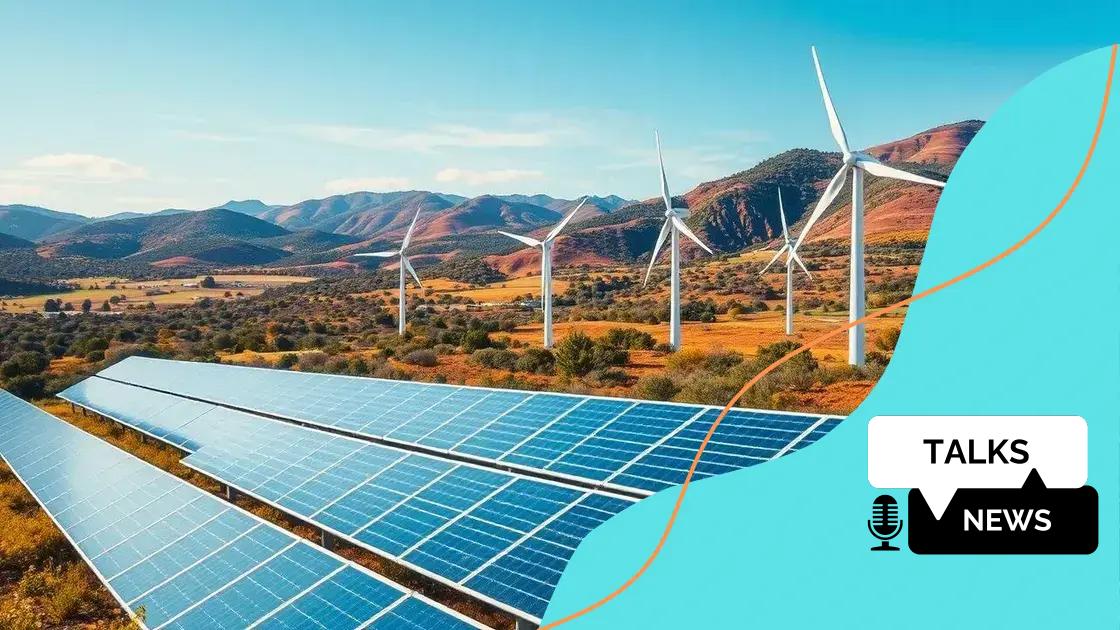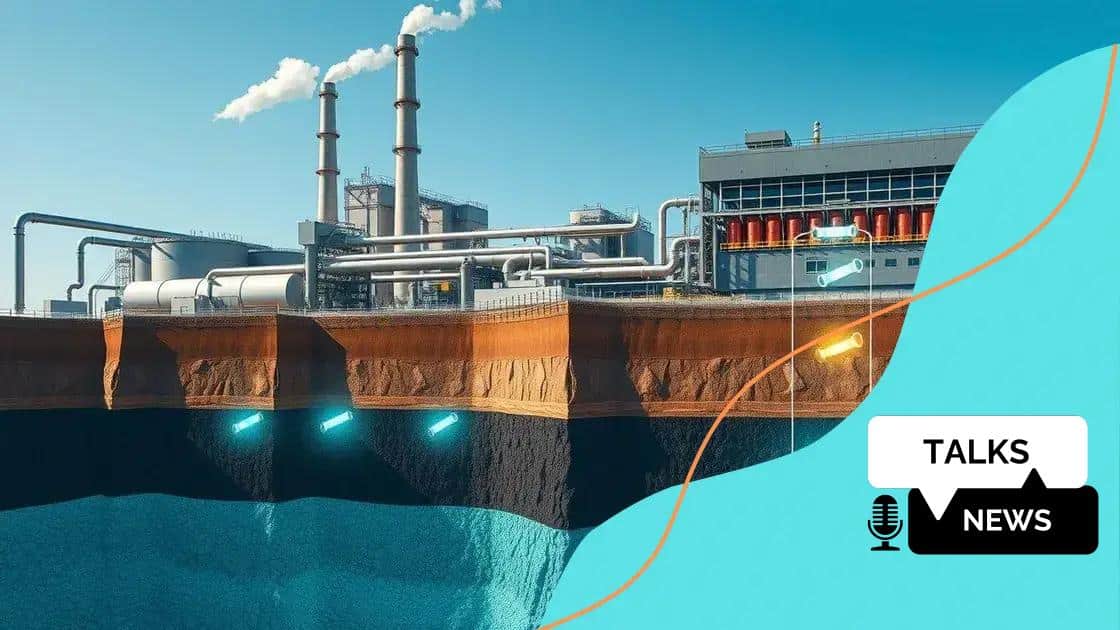Climate change mitigation tech advancements: a better future

Climate change mitigation technologies encompass innovative solutions like renewable energy sources and carbon capture, aimed at reducing greenhouse gas emissions and promoting sustainability in various sectors.
Climate change mitigation tech advancements play a crucial role in our fight against global warming. Have you ever wondered how technology can help heal our planet? In this article, we’ll explore groundbreaking innovations that are making a difference.
Understanding climate change mitigation technologies
Understanding climate change mitigation technologies is vital for addressing the urgent challenges posed by global warming. These technologies offer innovative solutions to reduce greenhouse gas emissions and enhance our environmental resilience. As we explore these advancements, it’s crucial to recognize their potential impact on our society.
Key Types of Mitigation Technologies
There are several key categories of climate change mitigation technologies, each focused on different aspects of reducing emissions:
- Renewable Energy Sources: Utilizing solar, wind, and hydroelectric power decreases reliance on fossil fuels.
- Energy Efficiency Improvements: Enhancing energy use in buildings and appliances helps to cut down on unnecessary consumption.
- Carbon Capture and Storage: This technology captures carbon dioxide emissions from sources like power plants and stores it underground.
- Alternative Fuels: Transitioning to biofuels and hydrogen can help reduce emissions in transportation.
Each of these categories plays a significant role in our transition to a more sustainable future. Renewable energy sources, for instance, not only contribute to emission reductions but also create jobs and stimulate economic growth.
Policy and Implementation Challenges
Despite their potential, implementing climate change mitigation technologies often faces obstacles. Awareness and accessibility of these technologies can vary significantly across regions. Moreover, the initial costs for installation or upgrading to cleaner technologies can be a barrier for many. Engaging policymakers to support these initiatives is crucial.
As consumers and businesses become more aware of the need for sustainability, the adoption of these technologies continues to rise. Some communities have already seen positive outcomes from publicly funded programs that support the implementation of green technologies.
Looking forward, the future of climate change mitigation technologies rests on collaborative efforts. Strong partnerships between governments, industries, and researchers will be essential to promote innovation and drive down costs. Through education and advocacy, we can enhance public understanding and support for these vital technologies.
Key advancements in renewable energy sources
Key advancements in renewable energy sources have transformed the way we generate power. From solar to wind energy, these innovations are paving the way for a sustainable future. As technology evolves, the efficiency and accessibility of these energy sources continue to improve, making them more viable options for consumers and businesses.
Solar Energy Innovations
One of the most significant advancements in renewable energy has been in solar technology. Modern solar panels are now more efficient, allowing them to convert more sunlight into electricity. The development of solar shingles offers an attractive option for homeowners, blending seamlessly with traditional roofing materials.
- Improved efficiency: New materials increase the energy conversion rates significantly.
- Energy storage: Better battery technology allows users to store excess energy for later use.
- Cost reduction: As production scales, prices for solar technology have dropped, making it more affordable.
Wind energy has also seen remarkable progress in recent years. Innovations in turbine design have increased their efficiency and effectiveness in harnessing wind energy. Many new wind farms are now equipped with taller turbines that can capture more wind and generate more power.
Advancements in Wind Energy
The rise of floating wind turbines represents a groundbreaking advancement. These platforms allow turbines to be placed in deeper waters, where winds are stronger and more consistent. Floating turbines open up vast areas for wind energy production that were previously unavailable.
As we explore these advancements, it’s essential to recognize the benefits of integrating various renewable energy sources. Combining solar and wind energy creates a resilient energy system that can meet demands even when one source is less productive. This hybrid approach contributes to a more stable and sustainable energy grid, ensuring we can rely on clean power at all times.
Finally, advancements in hydroelectric power are also noteworthy. New technologies enhance the efficiency of hydroelectric plants and improve their impact on local ecosystems. For instance, small-scale hydro systems are being developed that provide clean energy without the ecological concerns associated with traditional large dams.
Innovative carbon capture and storage techniques

Innovative carbon capture and storage techniques are essential in the fight against climate change. These technologies capture carbon dioxide (CO2) emissions from sources like power plants before they can enter the atmosphere. Once captured, the CO2 is transported and stored underground, reducing its impact on global warming.
How Carbon Capture Works
Carbon capture involves several steps. First, CO2 is captured from the exhaust gases. Technologies used for this process include:
- Post-combustion capture: This method extracts CO2 after fossil fuels have been burned.
- Pre-combustion capture: CO2 is removed before burning fuels, which can be more efficient.
- Oxy-fuel combustion: In this process, fuels are burned in pure oxygen instead of air, producing a concentrated stream of CO2.
Once the CO2 is captured, it is compressed for transportation. The next step is storage, which typically involves injecting the CO2 into deep geological formations. These formations can include depleted oil and gas fields or deep saline aquifers, which are layers of porous rock capable of holding the gas securely.
Benefits of Carbon Capture
Implementing carbon capture and storage (CCS) offers numerous benefits. By capturing CO2 emissions, we can:
- Reduce greenhouse gas emissions: This directly impacts the levels of CO2 in the atmosphere.
- Support transitioning energy sectors: CCS allows for continued use of fossil fuels while we shift to renewable energy sources.
- Enhance energy security: By maintaining reliable energy sources, we can boost energy independence.
Innovative applications of carbon capture technology are emerging. For example, some facilities are using captured CO2 to produce synthetic fuels or chemicals. This not only helps reduce emissions but also allows businesses to create new products from what was once a waste product.
Overall, the advancement of carbon capture and storage techniques represents a crucial step in mitigating climate change effects. As research and development continue, these technologies will play a vital role in achieving a sustainable energy future.
The role of policy in promoting green tech
The role of policy in promoting green tech is crucial for fostering a sustainable future. Effective policies can encourage the development and adoption of environmentally friendly technologies. Governments and organizations worldwide recognize the importance of creating an ecosystem that supports innovation.
Incentives for Green Technology
Governments can provide various incentives to stimulate green technology advancements. Some common incentives include:
- Tax credits: These can help lower the cost of implementing renewable energy solutions.
- Grants and subsidies: Financial support can reduce the initial investment needed for green tech projects.
- Regulatory support: Creating a favorable regulatory environment encourages businesses to explore and invest in sustainable practices.
Such incentives not only reduce the costs of green technology but also promote job creation in emerging industries. The combination of economic and environmental benefits makes a compelling case for policymakers to prioritize sustainable initiatives.
Setting Standards and Regulations
Policies can also establish standards and regulations that guide the development of green technologies. For example, emission standards for vehicles encourage manufacturers to create more efficient and environmentally friendly models. Additionally, building codes that require energy-efficient designs reduce overall energy consumption in homes and businesses.
Furthermore, international agreements play a vital role in driving global cooperation on climate action. Treaties like the Paris Agreement commit countries to reduce greenhouse gas emissions, urging nations to adopt green technologies. These global policies foster collaboration and information sharing between countries, accelerating progress toward shared environmental goals.
As more countries implement and strengthen policies promoting green tech, the transition to a sustainable future becomes increasingly achievable. Innovative policies can create a thriving market for renewable energy solutions while mitigating the impacts of climate change. The collaboration between governments, businesses, and communities is necessary to create lasting change.
Challenges and opportunities for future developments
Challenges and opportunities for future developments in climate change mitigation technologies present a complex landscape. As we advance our efforts toward sustainability, identifying obstacles and leveraging opportunities becomes crucial for progress.
Identifying Challenges
One major challenge is the high initial investment required for new green technologies. Many companies and governments may struggle to find funding for such projects. Additionally, the technology itself can be rapidly evolving, which creates uncertainty and potential obsolescence before an investment pays off.
- Public acceptance: People may resist changes to their lives, such as adopting new energy sources or transportation methods.
- Policy barriers: Existing regulations may not support innovative technologies, hindering their implementation.
- Technical limitations: Some technologies are still in the developmental stage and may not yet be fully reliable or efficient.
Despite these challenges, there are significant opportunities for businesses and governments to invest in sustainable technologies that can drive positive change. These advancements can lead to long-term benefits, such as lower energy costs and reduced environmental impact.
Exploring Opportunities
Investing in research and development presents a great opportunity for innovation in green tech. By funding projects focused on renewable energy, carbon capture, and sustainable materials, we can unlock new markets and drive economic growth. Collaboration among different sectors can also facilitate more comprehensive solutions to climate challenges.
Furthermore, there is a rising demand for green technologies among consumers. Many people are increasingly aware of their environmental impact and are seeking eco-friendly products and services. Businesses that respond to this demand can enjoy competitive advantages in the marketplace.
International cooperation can also amplify efforts to tackle climate change. By sharing knowledge, resources, and technologies, countries can accelerate their advancements and overcome shared challenges. These collaborative initiatives can lead to breakthroughs that benefit everyone globally.
FAQ – Frequently Asked Questions about Climate Change Mitigation Technologies
What are climate change mitigation technologies?
These technologies are designed to reduce greenhouse gas emissions and promote sustainable practices. They include renewable energy solutions like solar and wind power.
What are the main challenges facing green technology adoption?
Challenges include high initial costs, public acceptance, and existing policy barriers that hinder innovation and implementation.
How can policies promote green technology?
Policies can provide tax incentives, grants, and create a supportive regulatory environment that encourages businesses to invest in sustainable technologies.
What opportunities exist for the future of climate technologies?
Opportunities include increased investment in research and development, growing consumer demand for sustainable products, and international cooperation to tackle climate change.





